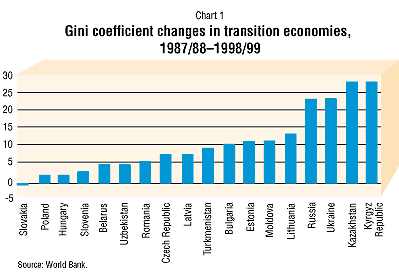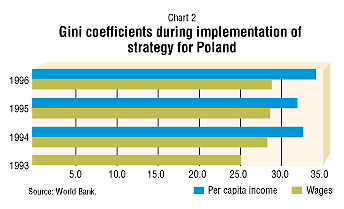 About F&D Subscribe Back Issues Write Us Copyright Information Use the free Adobe Acrobat Reader to view a pdf file of this article
|
Incomes Policy, Equity Issues, and Poverty Reduction in Transition Economies Grzegorz W. Kolodko Ensuring that income is fairly distributed is always a concern of policymakers, but such a focus is especially important during the early years of systemic change and contraction in transition economies. It is often difficult, when formulating policy in these countries, to resolve income distribution issues because of their social and political implications. Poland's experience suggests that fast growth makes a resolution easier. During the last years of socialism, a growing disparity in real incomes gave rise to widespread social dissatisfaction and political tension. After the transition process was launched, an excessive optimism that reforms would quickly and fairly distribute the fruits of a better-performing economy failed to take into account the complex history of industrial country development. As a general rule, centrally planned systems distribute income more evenly than do market and transition economies. Since the beginning of the transition, it can be seen that—while income distribution varies—all transition economies have had one common feature: income inequality is increasing. It cannot be denied that under central planning, there were rich and poor—though determining the number of each depends on how they are counted. But whatever method is used, the market transition has increased the numbers of both the rich and the poor, because, as inequality has increased, so has the number of people at each end of the spectrum. In the late 1980s, the Gini coefficients for socialist economies averaged 23 or 24 points. (The Gini coefficient measures income distribution: the lower the number, the more even the income distribution.) At the same time, the advanced market economies of Western Europe had average Gini coefficients 6 points higher than those of the countries of Eastern Europe (excluding the territory of the former Yugoslavia). Chart 1 shows that, since then, transition countries' Gini coefficients have worsened—in some countries quite dramatically. Rising income disparity There are several reasons for rising income inequality. One of the most immediate is the reduction of state subsidies. A central goal of the transition was to establish predominantly market pricing and, therefore, to eliminate subsidies. Removing subsidies has affected many social groups but has been especially hard on the poor, who have had to apply a larger portion of their disposable income to the purchase of formerly inexpensive goods and services. The state sector has also played a role. Economic reforms have freed wages and allowed incomes to diverge. As late as the mid-1990s, in most transition economies, the state sector continued to employ more than half the labor force, but the incomes of these state employees have become more tightly linked to qualifications, experience, occupation, and performance. Even in the state sector, the transition has meant a closer relation between an individual's past investment in human capital and that person's current remuneration. More decisive for rising income inequality has been the shift of labor from the state to the private sector. Not only do wages range more widely in the private sector than in the state sector, but the average income earned is higher, mainly because of the higher labor productivity in the private sector. The state, on the other hand, continues to run obsolete, noncompetitive industries and to provide poorly managed, low-paid services, such as education, health care, and central and local administration. Because of tight budgets, these sectors have been unable to compete with the pay scales of private industries, which are able to perform profitably on a commercial basis. Transition has created a newly affluent class. Most are well educated, hard-working people who are capable of taking care of their own wealth. Some are capable of establishing opportunities for others also to improve their standards of living. Unfortunately, because of weak institutional arrangements, others have moved into informal and sometimes even criminal activities. All transition countries harbor extensive shadow economies that operate parallel to the formal economy. The shadow, or underground, economy has a number of positive aspects. It fosters growth and, in the long run, raises living standards for society as a whole. Nevertheless, it seems clear that the shadow economy increases income inequality between those who engage in it and those who do not. Those who engage in it increase their disposable income without the burden of paying taxes. When an economy moves from a centrally planned to a free-market system, the most revolutionary and fundamental changes take place in asset ownership. Privatization, property restitution, participation of foreign direct and portfolio capital, and the development of financial intermediaries have created new inequalities in wealth and income. So has the high inflation suffered by many transition countries that has eroded the value of poor people's unindexed savings. Much of the growing inequity in income distribution is likely to be associated with the increasing share of capital gains during transition, that is, profits, dividends, interest, and rents. The case of Poland In Poland, all of these developments were important. Yet, in contrast to many other transition countries, its Gini coefficient worsened very little (Chart 1). This was due to the fact that, although Poland has recently enjoyed remarkable growth, especially in 1994-97, it suffered a deep economic crisis at the onset of transition. While the "liberalization-cum-stabilization policy" was expected to contract real GDP by only 3.1 percent, in reality GDP collapsed by about 12 percent in 1990 and by an additional 7.2 percent in 1991. Industrial output shrank by 40 percent, leading to mass unemployment. Despite a government forecast that unemployment would not exceed 5 percent, by the end of 1993 it had reached 16 percent. Year-end inflation reached about 250 percent in 1990 and still exceeded 70 percent in 1991. The fiscal deficit remained high, and in 1991-92 was at about 6.7 percent of GDP. That, indeed, was "shock without therapy." 
In 1993, after the initial sharp contraction, the government introduced its Strategy for Poland, a new program refocused toward "therapy without shock." This program was designed to foster development at the same time as transition. During 1994-97, Poland recorded a GDP growth rate of more than 28 percent, or an average of 6.4 percent a year. This growth was accompanied by further institutional reforms that brought Poland membership in the Organization for Economic Cooperation and Development in 1996 and, together with five other Eastern European nations, to formal negotiations for accession to the European Union in 1998. Moreover, Poland made further progress toward transforming stabilization into stability. Inflation fell from 37.7 percent at the end of 1993 to 13.2 percent at the end of 1997 and to 8.6 percent by the end of 1998. During the same period, the unemployment rate declined to 10.5 percent from 16.4 percent, and the fiscal-deficit-to-GDP ratio was held below 3 percent. Meanwhile, inequality grew only slowly (Chart 2)—much more slowly than elsewhere. By 1997, according to estimates, the Gini coefficient for Poland had declined to 31.0. This experience suggests that if a transition economy gets onto a path of fast growth and if equity issues are taken into account in the economic strategy, it may be possible to limit the growth of inequality. 
Addressing income inequality Poland's experience underlines the fact that issues of inequity and inequality can be addressed more easily when an economy is growing than when it is in recession. During a recession, the question is how can the loss of income be shared. In an expansion, the question becomes how should growing income be distributed. At least part of the response to that question is that incomes policy, as well as asset redistribution policy, should facilitate the accumulation of capital. This capital is a foundation for employment-creating investment. Employment creation, in turn, tends to make labor mobility easier—an important factor for equalizing incomes. During a period of strong growth, investment and employment creation are easier: growth facilitates capital formation and capital formation favors growth. Those who find jobs definitely gain from recovery and growth in a transition economy. In Poland's case, unemployment peaked in mid-1994 at close to 17 percent, or almost 3 million people. By the end of 1997, owing to an active employment policy that took advantage of targeted subsidized credit and fiscal instruments, joblessness fell by 1 million. These unemployment-lowering policies also reduced income inequality. If the type of incomes policy envisaged above is to be successful, it must be founded on public trust. When large elements of society are convinced that wealth accumulation depends on connections or dishonesty and that poverty is a result of the economic system, the future will not look bright. In Russia, the public is convinced—not without cause—that transition has brought with it corruption and crony capitalism, which are related to the continuing recession, growing inequality, and spreading poverty. Russia's Gini coefficient doubled in the first six years of transition and could well rise further. During transition, incomes policy must balance contradictory pressures. While the desire to encourage saving would indicate that some types of income should be taxed more leniently, the need to limit the growth of inequality suggests the opposite. The trade-off a country makes between the two will depend on its policy options. To help it develop quickly and expand, the discussion above suggests that some fiscal accommodation for capital gains might be useful. But this option may be politically difficult. Not only may there be populist tendencies in post-socialist societies, as well as among influential politicians, but also, taxing unemployment benefits and minimal pensions will seem anomalous if, at the same time, preferential treatment is given to capital gains on speculation in the stock exchange. A final challenge in addressing income inequality is posed by the time lag between recovery and the improvement of living standards. Real output recovers first, then employment grows, and finally the budget allows for better financing of the social needs of the poor. Thus, an economy may be on the rise, but it will take several years for the scale of poverty to decline. Conclusion Thus far, transition has brought mixed results. Policymakers now have to deal with growing inequality and the widening of poverty in transition countries. This challenge is made more difficult by the interrelationship between inequality and poverty, as well as by a severe, long-lasting recession. Income inequality can become a political issue that provokes tensions and conflicts and creates an economic obstacle to durable growth. When policymakers consider equity and equality issues, they have to have vision. The means of economic policy should not be confused with its ends. The goal of transition is not only systemic change but also, and more important, greater efficiency, increased competitiveness, faster growth, and more sustainable development. Inequality inevitably rises during transition, but sound policies should control and manage changes in inequity. The scope and the pace of these changes cannot be left entirely to just-released market forces. An acceptable distribution of income and wealth is one of society's most important long-term goals: transition is expected to improve the standard of living for the majority. Otherwise, the exercise would not make much sense. In the real world, it is difficult to accomplish these tasks and gather political support for the implementation of necessary measures. Politics and policymaking are nothing more than the ability to resolve, time and again, conflicts of interest. This is especially true during transition, when policies must shift from stabilization to growth and transform stabilization into lasting stability. A policymaker trying to catch up with a more advanced world and facing a trade-off between faster growth with higher inequality (but less poverty) and slower growth with lower inequality (but more poverty) can nonetheless be happy because the best choice is clear. Policy should facilitate sustainable growth, and incomes policy should support that goal. Then, in the longer run, everyone's standard of living may improve. After the initial surge of inequality, it may be possible to reduce the disparity without inhibiting expansion. Therefore, the more the transition advances and the stronger the foundations for fast and durable growth, the weaker the trade-off between equity and efficiency.
Further reading: Grzegorz W. Kolodko, From Shock to Therapy: The Political Economy of Postsocialist Transformation (forthcoming, Oxford University Press).
|